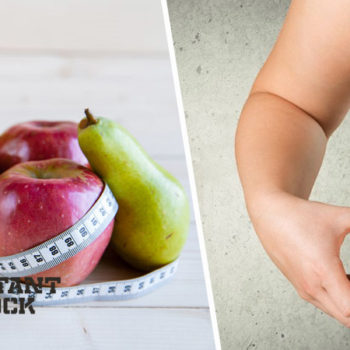Does Fidgeting Boost Fat Loss?

Fat loss is as simple as calories in versus calories out.
And whilst you can control what goes in your mouth in order to improve your physique, it’s just as important to focus on your activity levels too.
Whilst you might hit the gym for an hour each day, that still leaves a few hours of potential energy expenditure.
So what do you do to maximize fat loss away from the gym?
The simple answer is that you keep active – walk, dance and …. fidget.
That’s right.
And in this article we’ll tell you exactly why tapping and twitching might just be your key to a better body.
What Exactly is Fidgeting?
Fidgeting refers to any small movement of the hands, feet or body. It isn’t structured exercise, it’s not going for a walk. It’s the sort of thing you might catch yourself doing without even realiszing.
Often associated with nervousness or impatience, fidgeting could include:
- Hair twisting and nail biting
- Foot tapping or wriggling in your chair
- Twitching and shuffling
We’ve all got that friend that’s constantly tapping their feet or twiddling their hair. And the chances are they’re the ones with a great physique.
In the scientific literature you’re more likely to see fidgeting as incidental physical activity – and that’s anything categorized as light physical activity.
Why do we fidget?
You’ll see restless movement a lot in children.
They are constantly wanting to move, be active and find it hard to sit still – no matter how much you might tell them not to.
One theory is that kids are hardwired to fidget, not because they have no self control, but because their body’s need to exercise. It’s their way of letting off a little steam.
And it’s the same as in adult too, with leading researchers suggesting that fidgeting is your brain’s way of telling you that you’re ready to get up and move around.
So are you a fidgeter? How exactly do these movements add up to successful weight loss?
Let’s find out…
How Does Fidgeting Boost Fat Loss?
The key to burning fat is to boost your calorie output.
If you want to dip into your fat cells and break down stored energy you need to be in a calorie deficit. This means burning more off each day than you put in your body.
From exercise and physical activity, to basal metabolism – the energy needed to fuel your body functions at rest – you’re always using calories. Even when you’re asleep.
And one other way you’ll burn energy is through non-exercise activity thermogenesis or (NEAT).
NEAT ways to lose fat
NEAT refers to any energy expended that isn’t sleeping, eating or sports-like exercise [1]
And whilst these activities might not burn as many calories as say jogging or swimming, they soon add up.
So at only 1.29 kcal per minute, NEAT might not be a great minute-by-minute energy burner, but add that up over the course of a day and it soon makes a difference.
- Serial fidgeters can burn up to 10 times more calories per day.
Overweight People Move Less
According to research, those that are overweight are more likely to be inactive and less likely to walk, be on their feet or (you’ve guessed it) fidget.
A study published in Science [2] found that these unstructured movements could burn up to as much as 350 kcal per day. And over time, this could be the difference between losing 30 or 40 pounds in weight.
One thing the researchers did report was that they believed fidgeting was innate. Some people just moved more than others. And even when volunteers were gently reminded of their lack of movement, they didn’t increase it that much.
- The result: fidgeters are more likely to be at a healthy weight. Inactive people are more likely to be overweight.
Fidgeting is associated with cardio-respiratory fitness
A study published in a 2011 edition of Medicine and Science in Sport & Exercise [3] found that in a group of men and women, incidental physical activity was positively correlated with body mass as well as fitness levels.
- The result: The fitter you are, the more you’ll fidget… and the lower your body mass will be too.
So How Many Calories Does Fidgeting Burn?
A very interesting study published in the American Journal of Clinical Nutrition [4] sought to find out the answer this to this very question.
Led by renowned expert in the area of non-exercise activity James Levine, researchers recruited 17 women and 7 men and then measured their energy expenditure while they held different positions and postures.
- Lying motionless in a darkened room
- Sitting comfortably in a reclining chair or fidgeting while seated
- Standing motionless or fidgeting while standing
- Walking on a treadmill
The results – did fidgeting burn more energy?
Most definitely.
In a seated position, the volunteers burned over 3.5% more calories than lying down and a massive 54% more calories when they fidgeted.
When stood still they only burned 13% more than lying down. But add in fidgeting and that went up to a huge 154% more calories burned.
If you apply that to the real world, that’s around 600 kcal a day just from tapping, shuffling and finger drumming.
And just to provide context – walking at 2 mph burned just over 200% more calories than lying down. That’s more than fidgeting… but not that much more.
- The result: you’ll burn nearly as many calories fidgeting as you will walking at a slow pace.
Summary
Fidgeting is characterized by any low intensity movement that involves foot or finger tapping, changing posture or movements that are restless in nature.
And whilst it might be associated with nervousness, low intensity movements can soon ramp up your energy expenditure.
So if you want to burn fat then combine regular physical activity and exercise with unstructured, unplanned fidgeting. Keep on the move and before you know if you’ll be shredding fat and have the body you’ve been after.



